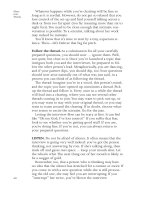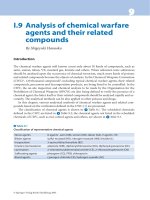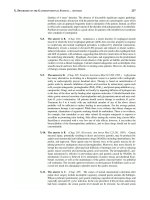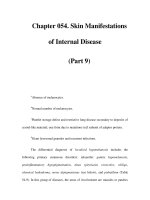The Gist of Emergency Medicine - part 9 ppt
Bạn đang xem bản rút gọn của tài liệu. Xem và tải ngay bản đầy đủ của tài liệu tại đây (57.17 KB, 19 trang )
The Gist of Emergency Medicine
Poisoning
153
L ABC’s and supportive care (for example, ringers prn, bicarb prn, blood products prn, 50% dextrose prn),
gastric lavage prn, whole bowel irrigation prn (x-rays will demonstrate the iron tablets), deferoxamine
mesylate 15mg/kg/hr/I.V. prn to 6 grams/day (until the urine is no longer pink = no free plasma iron) →
give the deferoxamine on clinical impression, before the serum iron level is back (maintain an adequate
urine output) → continue the deferoxamine if the patient is put on charcoal hemoperfusion/dialysis;
gastrotomy prn.
(B) Heavy metal poisoning
→ consult references, e.g. lead, arsenic, mercury.
→ All interfere with enzyme activity by attaching to the sulfhydryl groups, resulting in neurological,
cardiovascular, gastrointestinal, hematological, and renal manifestations ± others.
→ Diagnosis → e.g. bluish gingival and long bone lead lines, metallic flecks on abdominal. x-rays, basophilic
stippling of RBC’s, elevated blood lead levels, elevated 24 hour urine arsenic or mercury levels. Arsenic
poisoning may result from naturally occurring contaminated well water.
→ L ABC’s → treat, for example, seizures, arrhythmias, hypotension, renal failure → decontaminate prn, e.g.
gastric lavage prn, charcoal prn, whole bowel irrigation prn, chelation therapy prn (for example, BAL,
CaNa
2
- EDTA, D-penicillamine, 2,3-DMSA), dialysis prn. Prevent reoccurrence. Evaluate family,
significant others, and coworkers prn.
(20) Tar and asphalt burns
L ACBC’s, cool with H
2
O prn, use neosporin
®
/polysporin
®
ung to dislodge from skin, burn care.
(21) TWENTY-ONE
(A) Hydrocarbon poisoning
→ epinephrine contraindicated.
→ remember to decontaminate the skin prn.
(1) Liquid petroleum distillates, e.g. kerosene → gastric lavage only if it contains a toxic substance, e.g.
pesticide; look for chemical pneumonitis (delayed 24hrs?).
The Gist of Emergency Medicine
Poisoning
154
L ABC’s, 100% O
2
prn, and supportive care.
(2) Gases, e.g. propane → asphyxia, intoxication, arrhythmias.
L ABC’s, 100% O
2
prn, and supportive care. Hyperbaric O
2
?
(3) Solvents, e.g. benzene, epoxy
→ chemical pneumonitis, seizures, systemic toxicity, aplastic anemia.
L ABC’s, 100% O
2
prn, valium
®
prn, lavage prn, charcoal prn, and supportive care.
(4) Halogenated hydrocarbons, e.g. methyl chloroform, carbon tetrachloride
→ CNS toxicity, hepatitis, nephritis.
L ABC’s, lavage prn, charcoal prn, and supportive care.
(B) Irritant gases e.g. chlorine, phosgene.
→ upper airway obstruction, lower airway injury, chemical pneumonitis, and pulmonary edema.
L ABC’s, 100% O
2
prn, racemic epinephrine/ventolin
®
aerosols prn, and supportive care. Admit ICU prn.
(22) Caustic ingestions
→ for example, lye → liquefaction necrosis; acids → coagulation necrosis.
→ upper airway obstruction?
L ABC’s, 100% O
2
prn, I.V. Zantac
®
, esophageal perforation? → presumptive antibiotic therapy prn (e.g.
mefoxin
®
3g or 40mg/kg I.V., and clindamycin 600mg or 10mg/kg I.V.) → refer immediately (e.g.
endoscopic exam?). Steroids?? Remember that patients with esophageal burns may not have oral lesions.
Button batteries lodged in the esophagus need to be removed emergently.
(23) TWENTY THREE
(A) Organophosphate and carbamate poisoning
→ inhibition of acetylcholinesterase.
→ decrease in serum cholinesterase (20-50% of normal level = mild toxicity, 10-20%= moderate toxicity,
less than 10%= severe toxicity).
→ ports of entry (e.g. insecticides) are predominately skin, lungs, and GI.
The Gist of Emergency Medicine
Poisoning
155
→ muscarinic effects (parasympathomimetic), nicotine effects (motor), and CNS effects (e.g. seizures, coma,
cardiopulmonary depression).
→ mnemonic: DUMBELS: diarrhea, urination, miosis, bradycardia, bronchorrhea, bronchospasm, excitation,
lacrimation, salivation.
L ABC’s, support ventilation prn, 100% O
2
prn, ventolin
®
aerosols prn, atropine I.V. prn (atropinization),
decontamination of patient (wear gloves and protective clothing prn), I.V. pralidoxime chloride prn.
→ large doses of atropine may be required (antimuscarinic only).
→ give pralidoxime chloride on clinical impression.
→ 1-2g, or 20-50mg/kg, over 30min → repeat in 2 hours prn (serum cholinesterase level?), then q12h prn.
→ pralidoxime is antimuscarinic, antinicotinic, and counters the CNS cholinergic effects.
→ L seizures with valium
®
prn; arrhythmias with ACLS drugs prn, pacing prn, cardioversion prn.
Antihypertensives prn, hyperglycemia?
(B) Anticholinergic poisoning
→ e.g. benadryl
®
, dimenhydrinate, mushrooms.
→ anxious, dilated pupils.
→ they babble back when you speak to them.
→ they pick with their fingers, at you, the bed sheets, the air, or whatever is available.
→ tachycardia, hypertension, arrhythmias, seizures, coma.
L ACBC’s, supportive care, lavage/charcoal/sorbitol prn, ringers prn, bicarb prn, physostigmine prn (for
example, L of SVT, hypertension, or seizures, careful!, consult references), lidocaine prn, dilantin
®
prn,
valium
®
prn, refer prn, admit ICU prn. Do not use physostigmine with tricyclic antidepressant overdose.
→ concomitant trauma?
The Gist of Emergency Medicine
Environmental Injuries
156
XVI. ENVIRONMENTAL INJURIES
(1) Frostbite
L ABC’s, active external rewarming, L like burns; tetanus prophylaxis prn, narcotics prn, antibiotics prn,
ASA prn, delay surgery, rhabdomyolysis?, hyperbaric O
2
?
→ only rewarm if there is no chance of refreezing during transport.
(2) Hypothermia
32 - 35°C → excitation stage (inappropriate behavior, e.g. hiding from rescuers, combativeness)
< 32°C → adynamic stage
< 30°C → shivering stops
L careful handling, ACBC’s, warm 100% O
2
, reverse trendelenburg prn, cardiac cathader/rectal probe
temperature monitoring prn, active core rewarming prn, warm saline boluses prn (40-45°), thiamine prn,
dextrose prn, lidocaine prn, bretylium prn, narcan
®
prn, flumazenil prn, Solu-cortef
®
/decadron
®
? prn,
tagamet
®
prn, tetanus prophylaxis prn, associated trauma or disease?, alcohol or drug abuse?, myxedema
coma?, continue CPR until body temperature is 30-34°C (“no one is dead until warm and dead”). Watch for
complications, for example, ventricular fibrillation, increased intracranial pressure, renal failure, sepsis, GI
bleeding, hyperkalemia, pancreatitis, DVT, ARDS, DIC. Admit ICU prn.
→ defibrillation ineffective with core temperatures < 30°C, only one attempt at a time, consider lidocaine,
consider bretylium.
→ mild hypothermia may require external warming only.
→ examples of active core rewarming are: warm (40-45°C) → O
2
, I.V. fluids, gastric or rectal lavage,
peritoneal dialysis, extracorporeal rewarming. See also #(17) p.161, #(2) p. 57, #(16)(A) p. 70.
(3) Heat cramps, heat syncope
→ L ABC’s, rest in cool environment, hydrate prn with I.V. NS, or electrolyte drinks. Rule out heat stroke.
Heat exhaustion
→ headache, nausea, weakness, dehydration, pyrexia
The Gist of Emergency Medicine
Environmental Injuries
157
→ L ABC’s, rest in cool environment, hydrate with 1-2 liters D
5
saline (20mL/kg bolus(es) in children), rule
out heat stroke.
(4) Heat stroke
→ life threatening, multiple organ dysfunction.
→ may present with seizures, coma, or bizarre behavior.
L ABC’s, 100% O
2
prn, supportive care, I.V. valium
®
prn, active external and core cooling (reduce body
temperature to 39°C). Arrhythmia?, myoglobinuria?, hypoglycemia?, hyperkalemia?, DIC? Rule out other
causes, e.g. thyroid storm. Admit ICU.
(5) Rabies
→ rare in rodents.
→ skunks, bats, raccoons, cows, dogs, foxes, and cats are the frequent carriers.
L ABC’s, wound care, tetanus prophylaxis prn, antibiotics prn, and the following:
→ post exposure prophylaxis
→ irrigate the wound with 70% alcohol
→ rabies immune globulin 20 units/kg, 1/2 in the wound, 1/2 in the buttocks
→ human diploid cell vaccine 1mL @ 0, 3, 7, 14, and 28 days, then do serum antibody titers
→ repeat 1mL prn
→ if possible, observe the animal for 2 weeks, and do a postmortem if the animal dies.
(6) Hymenoptera stings
→ local, toxic, anaphylactic, and delayed serum sickness reactions.
→ L ABC’s, 100% O
2
prn, L allergic/anaphylactic reactions (see #(7)(A),(C),(E), pp.136-137), local
treatment/remove stinger.
(7) Pus caterpillar sting
→ L ABC’s, supportive care → remove the stingers with cellophane tape
The Gist of Emergency Medicine
Environmental Injuries
158
→ 10% calcium gluconate, 1-10ml slowly I.V. prn for pain.
(8) Tick-borne disease
Rocky mountain spotted fever (Rickettsia Rickettsii) → systemic symptoms → rash begins on second to fifth
day on wrists, ankles, and feet, and spreads centrally (may become purpuric).
L ABC’s, 100% O
2
prn, supportive care, antibiotics, e.g. tetracycline, doxycycline, or chloramplenical po or
I.V. prn (skin biopsy and immunofluorescent antibody staining?). DIC?
Lyme disease → tick borne spirochete.
→ Stage I: 7± days after tick bite
→ erythema chronicum migrans ± systemic symptoms.
→ Stage II: 4
+
weeks
→ neurological manifestations (± focal signs), ± A-V block, ± other multisystem manifestations, e.g.
hepatitis.
± Stage III: 4
+
weeks → arthritis, ± neurological signs.
Diagnosis → search for tick
→ specific antibody titer (stages II, III).
L ABC’s, an antibiotic for 10-30 days, e.g. tetracycline, vibramycin
®
(first choice for non-CNS lyme
disease), erythromycin, amoxil
®
, PenV, or I.V. ceftriaxone (for CNS involvement).
Tick paralysis → ascending, flaccid paralysis.
L ABC’s, supportive care, remove tick.
(9) Black widow spider bites
→ history of a bite may be absent
→ CNS excitement, muscle spasms, pain, paresthesias, hypertension, vomiting.
→ complications, e.g. seizures, shock, ascending paralysis, coma, respiratory arrest.
L ABC’s, supportive care, analgesics prn, corticosteroids prn, tetanus prophylaxis prn, valium
®
prn, 10%
calcium gluconate, 1-10cc slowly I.V. prn for pain, antivenim prn.
The Gist of Emergency Medicine
Environmental Injuries
159
(10) Brown recluse spider bites
→ local lesion, ± systemic manifestations, ± complications, e.g. seizures, shock, hemolysis, DIC.
L ABC’s, supportive care, analgesics prn, corticosteroids prn, valium
®
prn, dapsone 25-50mg qid X 1 week
(G6PD screen prn), antibiotics prn, local wound care, tetanus prophylaxis prn, and hyperbaric O
2
prn.
Admit ICU prn.
(11) Reptile bites
→ pit viper or coral snakes?
→ envenomation?, paresthesias?
→ hemopathic, neurotoxic, and systemic effects.
L ABC’s, 10% calcium gluconate, 1-10cc slowly I.V. for seizures (plus valium
®
prn), bolus(es) of ringers
prn, multiple doses of antivenim prn (consult references), blood products prn, tetanus prophylaxis prn,
antibiotics prn, local lidocaine ± epinephrine (if not contraindicated) prn, analgesics prn (no ASA), steroids
prn, keep part dependent prn, and repeated measurement of circumference of involved extremity prn,
remove jewelry prn, surgery prn (compartment syndrome?), admit ICU prn, DIC?, myoglobinuria?
(12) Arizona scorpion sting
→ cholinergic → opiates are contraindicated.
L ABC’s, atropine prn, antivenim prn, benadryl
®
prn, wound care, tetanus prophylaxis prn, admit ICU prn.
See also #(23)(A), p.154.
(13) THIRTEEN
(A) Marine misadventures
→ for example, near drowning, divers’ problems, trauma, foreign body, envenomation, infection.
L ACBC’s, primary, secondary, or tertiary wound closure prn, tetanus prophylaxis prn, cephalosporins prn,
hyperbaric O
2
prn, admit ICU prn. See #(2), p.156, #(17), p.161.
The Gist of Emergency Medicine
Environmental Injuries
160
Spine puncture wounds L ACBC’s, supportive care, lidocaine prn, demerol
®
prn, antivenim prn if available,
and local hot water L prn (45-50°C X 7-90 minutes); debride and explore prn, tetanus prophylaxis prn,
antibiotics prn (e.g. Bactrim
®
), admit ICU prn.
Coelenterate stings L ABC’s, supportive care, and local vinegar.
Sponge poisoning L ABC’s, supportive care, and local vinegar.
(B) Stingray
→ envenomation and local trauma, ± near drowning.
→ severe pain, bleeding, ± multisystemic manifestations.
→ L ACBC’s, supportive care, local hot water L prn (45-50°C X ½ - 1hr), local or regional lidocaine block
prn, debridement prn, tetanus prophylaxis prn, antibiotics prn (e.g. Cipro
®
), steroids prn, admit ICU prn.
(C) Portuguese Man of War
→ envenomation, ± near drowning.
→ pain, bullae, ± multisystemic manifestations.
→ L ACBC’s, supportive care, irrigate wound with saline → vinegar, shave off nemacysts, local and
systemic steroids prn, tetanus prophylaxis prn, admit ICU prn.
(D) Sea Urchin
→ envenomation, ± near drowning.
→ pain, ± multisystemic manifestations.
→ L ACBC’s, supportive care, local hot water L prn (45-50°C X ½ - 1hr), lidocaine prn, debride and
explore prn, tetanus prophylaxis prn, antibiotics prn, steroids prn, admit ICU prn.
(14) High altitude illness
Acute mountain sickness L bedrest, 100% O
2
, diamox
®
, descent prn, HBO
2
?
High altitude pulmonary edema (HAPE) L bedrest, 100% O
2
, descent, HBO
2
?
High altitude cerebral edema (HACE) L bedrest, 100% O
2
, descent, HBO
2
?
High altitude retinopathy L bedrest, 100% O
2
, descent, HBO
2
?
The Gist of Emergency Medicine
Environmental Injuries
161
(15) Dysbarism
Barotrauma of descent → squeeze → barotitis media → rupture of TM? → rupture of round or oval window?
→ perilymph fistula? → refer ENT.
Barotrauma of ascent
→ Alternobaric vertigo.
→ Pulmonary over pressure syndrome (POPS) → mediastinal or subcutaneous emphysema?,
pneumothorax?, air embolism?
→ Air embolism (dramatic symptoms in < 10minutes) → e.g. CNS and/or cardiovascular manifestations.
→ Nitrogen narcosis.
→ Decompression sickness → nitrogen bubbles → “the bends” (joints, skin), “the chokes” (pulmonary
arterial system), CNS manifestations (e.g. coma); shock.
→ L ACBC’s, 100% O
2
, extreme trendelenburg prn, I.V. fluids prn, analgesics prn, immediate
recompression prn, and L other problems, e.g. injuries, DIC.
(16) Blast injuries
→ TM rupture?
→ L as multiple trauma
L ACBC’s, treat specific injuries, hyperbaric O
2
prn (HBO
2
).
(17) Near drowning
L ACBC’s, 100% O
2
, ventolin
®
aerosols prn, reverse trendelenburg prn, supportive care, hyperbaric O
2
?,
antibiotics?, decadron
®
?, admit ICU prn; immersion in warm or cold water?, hypothermia?, associated
injuries? (e.g. head and/or cervical spine/cord), alcohol and/or drug abuse?, suicide or homicide attempt?,
MI?, CVA?, hypoglycemia?, seizure?, child abuse?, see also #(2), p.156, #(13), p.159, #(15), p.161, #(18),
p.162.
→ “No one is dead until warm and dead.” (30-34°C)
The Gist of Emergency Medicine
Environmental Injuries
162
→ A successful resuscitation may be followed by a delayed multiple system failure (e.g. ARDS, DIC,
increased intracranial pressure, lactic acidosis). See also #(4), p.97, #(11)(C), p.121, #9, p. 37, #(4), p.118.
(18) Delayed immersion syndrome
→ delayed pulmonary edema? (usually symptoms < 4 hours).
→ L as ARDS. See also #(17), p.161, #(4), p.97.
(19) Burns
→ Remember the smoke threats: (1) heat (e.g. upper airway obstruction), (2) asphyxiants (e.g. CO, cyanide),
and (3) airway and pulmonary irritants, (e.g. carbon ± toxic chemicals, phosgene → upper airway
obstruction, bronchospasm, pulmonary edema).
→ occurred in closed or open space?, toxic combustion gases?
→ first degree burns (erythema, pain), second degree burns (erythema, pain, blistering), or third degree burns
(pale, leather-like, painless, absent sensation).
→ Rule of 9’s for adult body surface estimate:
head and arms 9 X 3 = 27 %
trunk 18 X 2 = 36 %
legs 18 X 2 = 36 %
genitalia = 1%
100%
→ children (child abuse?, e.g. scalds) → head and neck 15-20%, arms 10% X 2, trunk 20% X 2, legs 10-15%
X 2. Consult burn estimate charts prn.
→ palmar surface of patient’s hand equals approximately 1% of total body surface.
→ beware of burns of face, eyes, ears, hands, feet, and perineum.
→ L ACBC’s, 100% O
2
prn, pulse oximetry/ABG’s prn, inhalation injury? (serial chest x-rays prn), upper
airway edema?, early prophylactic intubation prn (early laryngoscopic/bronchoscopy?), racemic
epinephrine/ventolin
®
aerosols prn, CO poisoning?, cyanide poisoning? (? presumptive sodium thiosulfate
25% 1mL/kg/I.V.), hypovolemic shock?, lactic acidosis?, emergency escharotomy prn (neck, chest,
The Gist of Emergency Medicine
Environmental Injuries
163
extremities), Xmatch prn, ringers prn (children 20mL/kg bolus(es) prn), blood products prn, L other trauma
plus new and preexisting medical problems prn (alcohol or drug abuse?), analgesics prn (e.g. I.V.
morphine), antibiotics prn (I.V. prn), ng/foley prn, tetanus prophylaxis prn, flow sheet prn, local burn
care/appropriate dressings prn, remove watch and jewelry prn, clean dry sheet prn, I.V./po tagamet
®
prn
(stress ulcer prophylaxis), to burn centre prn. Patients may develop a delayed chest infection or sepsis
(upper airway obstruction and pulmonary edema may also have a delayed onset).
→ I.V. ringers 4ml X kg X % burn/day → 1/2 in the first 8 hours after the burn, the rest in the next 16 hours →
maintain an adequate urine output (1cc/kg/hr for children to 50
+
cc hr for adults; myoglobulinuria?). This is
in addition to bolus(es) of ringers for hypovolemic shock (follow the electrolytes). Inadequate fluid
resuscitation can also result in acute renal failure, which may be fatal.
→ See also #(20), (21), (22), pp. 163-164.
(20) Chemical burns
L ABC’s → irrigate with large volume of water, consult references for specific antidotes, e.g. hydrofluoric
acid burn L topical and s.c. 10% calcium gluconate prn.
→ See also #(19), (21), (22), pp.162-164.
(21) Electrical injuries
→ AC/DC current?
→ immediate threats: cardiac and/or respiratory arrest.
→ may have progressive intravascular thrombosis, and/or rhabdomyolysis, ± renal failure, ± other injuries
(e.g. cervical spine), ± myoglobinuria, ± hyperkalemia, ± hypovolemic shock/acidosis, ± entrance/exit
wounds.
L ACBC’s, 100% O
2
prn, supportive care, saline boluses prn, ± dopamine prn, escharotomy/ fasciotomies
prn, extended cardiac monitoring prn, tetanus prophylaxis prn, to burn centre prn. See also #(19), (20), (22),
pp.162- 164, and #(18), p.173
The Gist of Emergency Medicine
Environmental Injuries
164
(22) Lightning injuries
→ L as multiple trauma → secondary cardiac arrest due to prolonged respiratory arrest; electrical injuries,
blast injuries, burns, CNS damage
→ L ACBC’s, 100% O
2
prn, tetanus prophylaxis prn, plus specific L, to burn centre prn.
→ See also #(19)-(21), pp.162-163.
(23) Acute exposure to toxic agents
L ACBC’s, 100% O
2
prn, protect rescuers, decontamination, consult references, specific L.
(24) TWENTY-FOUR
(A) Cyanide poisoning
L ABC’s, 100% O
2
, amyl nitrite inhalation, 3% sodium nitrite 0.2mL/kg to 10mL, sodium thiosulfate 25%
50ml (1mL/kg) I.V. (converts cyanide to nontoxic thiocyanate), vitamin B
12a
?, charcoal prn, HBO
2
prn.
(B) Hydrogen sulfide gas poisoning
→ cellular asphyxiant similar to cyanide.
L ABC’s, 100% O
2
, 3% sodium nitrite, 0.2mL/kg to 10ml, HBO
2
prn.
(25) Methemoglobinemia
→ exposure to, for example, nitrates, nitrites, sulfas, mushrooms.
L ABC’s, 100% O
2
, remove causative agent, 1% methylene blue prn 0.1cc/kg/I.V. → repeat in 1hr prn then
q4-6h prn, exchange transfusions prn, HBO
2
prn.
(26) Sulfhemoglobinemia
→ exposure to, for example, phenacetin, acetanilid.
→ irreversible → L ABC’s, 100% O
2
, remove causative agent, exchange transfusions prn, HBO
2
prn.
The Gist of Emergency Medicine
Environmental Injuries
165
(27) TWENTY-SEVEN
(A) Phenol poisoning
→ absorbed through the skin → multisystem toxicity.
L ABC’s, copious H
2
O irrigation, wash with glycerol, repeat H
2
O irrigation.
(B) Phosphorus burns
L ABC’s, copious H
2
O irrigation, debridement.
(28) Carbon Monoxide poisoning
→ other victims? (e.g. co-workers, family members), flu-like symptoms?
→ treat on clinical grounds while obtaining a carboxyhemoglobin level (have a low threshold for doing
COHB levels. Smoker?).
→ contamination of the cellular cytochrome systems may continue after the COHB has returned to a low
level → do not hesitate to contact your local hyperbaric consultant prn.
L ACBC’s, 100% O
2
, COHB level, HBO
2
prn. Myoglobulinuria?
→ remember that the family with the “flu” may have CO poisoning (e.g. malfunctioning gas/oil
heater/furnace → “the CO flu” that can result in death or permanent neurological impairment).
(29) Radiation Injuries
→ Nausea and vomiting in less than 2 hours indicates an exposure of 400
+
rem.
→ Lymphocyte count at 48 hours:
> 1200 = good prognosis
300-1200 = fair prognosis
< 300 = poor prognosis.
→ Potassium Iodine (begin in less than one hour if possible)
< 1 year 65mg daily/po x 2 weeks
> 1 year 130mg daily/po x 2 weeks.
The Gist of Emergency Medicine
Environmental Injuries
166
→ L ACBC’s, protect rescuers, decontamination, protective isolation prn, CBC/platelet count q6h prn,
supportive care, appropriate consultations prn.
(30) THIRTY
(A) Mushroom poisoning
→ nausea and vomiting beginning > 6hrs after ingestion may indicate a potentially lethal group → identify
the mushroom(s) if possible (multiple type ingestion?) → pictorial reference?, mycologist?, multiple
victims?
Group I → liver and/or renal impairment (amatoxin).
L ABC’s, supportive care, decontamination, I.V. fluids prn, pen G I.V. prn, dialysis prn. Liver
transplantation?
Group II → anticholinergic intoxication
L ABC’s, decontamination, supportive care, physostigmine? See also #(23)(B), p.155.
Group III → methemoglobinemia, or hemolytic anemia, or isoniazid like poisoning.
L ABC’s, decontamination, 1% methylene blue, 0.1ml/kg I.V. prn, or PRBC’s prn, or pyridoxine 1-5g I.V.
prn as indicated. See also #(25), p.164, #(13)(A), p.121, #(17)(B), p.151.
Group IV → cholinergic
L ABC’s, atropine prn (antimuscarinic only), decontamination, supportive care. See also #(23)(A), p.154.
Group V → antabuse
®
like reaction
L ABC’s, decontamination, supportive care.
Group VI → dysphoric state
L ABC’s, decontamination, supportive care, valium
®
prn. Cortinarius mushrooms may be mistaken for
“magic” mushrooms, and if ingested can result in acute renal failure. The clue is that the patient does not
experience the “magic” with cortinarius mushrooms. Caution: the patient may not volunteer, or may deny,
the ingestion of mushrooms.
Group VII → GI effects only, onset < 2hrs
L ABC’s, decontamination, I.V. fluids prn, supportive care, pyridoxine I.V.?
The Gist of Emergency Medicine
Environmental Injuries
167
(B) Poisonous plants
→ pictorial references?, botanist?
→ toxins, for example, calcium oxalate, cyanide, digitalis, anticholinergics, nicotine and like, GI toxins.
→ L ABC’s, decontaminate, supportive care, specific L.
(C) Illness associated with seafood
→ multiple victims?
1. Infections
• Bacterial e.g. cholera, salmonella, shigella, staph, bacillus cereus, E. Coli, botulism.
• Viral e.g. hepatitis A, norwalk.
• Parasitic e.g. fluke, tapeworm.
L ABC’s, supportive care, consult references prn, specific L prn, e.g. antibiotics, antitoxins; admit ICU prn.
→ the above also applies to non-seafood food poisoning, for example, salads/staph. aureus,
poultry/salmonella, hamburger/bacillus cereus/E. Coli (may develop hemorrhagic colitis/hemolytic-uremic
syndrome, See #(10)(B), p.87).
2. Intoxications, for example, paralytic shellfish poisoning, diarrhetic shellfish poisoning, scombroid fish
poisoning (histamine poisoning), ciguatera (multisystem manifestations). Beware of a fulminating
sensorimotor polyneuropathy.
L ABC’s, intubate and ventilate prn, supportive care, gastric lavage/charcoal/sorbitol prn, consult
references prn, specific L prn, e.g. antivenim; admit ICU prn.
(D) Traveler’s diarrhea
L cipro
®
500mg bid or bactrim tabs II bid; ± peptobismal.
The Gist of Emergency Medicine
Trauma
168
XVII. TRAUMA
(1) Trauma
→ L ACBC’s, supportive care, treat the specific injuries, and any preexisting medical conditions, e.g.
diabetes mellitus. Is the patient on anticoagulants? Obtain an ethanol level prn. Be on the lookout for child
abuse.
→ injuries are the result of a suicide attempt?, e.g. motor vehicle accident → or the MVA was a result of:
alcohol and/or drug abuse?, MI?, CVA?, seizure?, narcolepsy?, hypoglycemia?
Head injury (+ neck injury?) → mild = Glasgow scale 13-15, moderate = 9-12, severe = 3-8; loss of
consciousness?, combative?, memory or focal deficit?, rectal exam? (anal sensation and sphincter tone?).
→ Head injury can result in upper airway obstruction but rarely shock (e.g. an infant with an arterial bleed
from a scalp laceration). If shock is present, look for another etiology (e.g. fractured pelvis).
→ All significant head injuries require CT scanning or MRI → e.g. epidural hemorrhage? (may require stat
burr holes before scanning), subdural hemorrhage?, subarachnoid hemorrhage?, intracerebral hematoma?,
cerebral contusion or laceration?, depressed skull fracture?, basilar fracture? (blood behind TM?, CSF
leak?), penetrating injury? (do not attempt to remove the F.B. in the ER, e.g. arrow).
→ Avoid hypoxemia, hypercapnia, agitation, seizures, pyrexia, and cerebral edema.
→ L ACBC’s, 100% O
2
prn, pulse oximetry prn, thiamine prn, dextrose prn, narcan
®
prn, flumazenil prn,
maintain a systolic pressure > 80 (boluses of ringers prn → maintenance rate once stabilized), arterial blood
gases prn, intubate prn, and hyperventilate prn with 100% O
2
to a pCO
2
25-30, mannitol prn 20% 5-
10cc/kg/I.V. (caution), decadron
®
prn/initial dose 1mg/kg/to 50mg I.V. (plus Zantac
®
50mg I.V. q8h for
stress ulcer prophylaxis); seizures? (or prophylaxis) → I.V. valium
®
5-10mg prn and/or I.V. dilantin
®
15mg/kg/loading dose/prn, neuromuscular blockade prn; hyperglycemia?, fibrinogen < 250? →
FFP/cryoprecipitate prn
*
; L pyrexia; antibiotics prn, analgesics prn, head elevated 30°, immediate
*
See Cryoprecipitate, #(9)(C), p. 120.
The Gist of Emergency Medicine
Trauma
169
neurosurgical consultation prn. Haldol
®
5-10mg I.V. prn is useful for uncontrollable agitation (concomitant
cervical spine injury?).
(2) Spine/cord injuries
→ often an anxiety producing diagnostic problem.
→ the patient may have a multiple level injury.
→ L ACBC’s → avoid excessive traction or movement → L all suspected spinal fractures as unstable until
proven otherwise (immobilize) → x-rays negative? → CT scan prn, MRI prn (soft tissue injury?), refer prn.
If spinal injuries with neurological deficit are less than eight hours old, consider giving bolus of
solu-medrol
®
(methylprednisolone) 30mg/kg/I.V. followed by 5.4mg/kg/hr/I.V. for 23 hours (plus Zantac
®
I.V. for stress ulcer prophylaxis).
Spinal shock → flaccid paralysis → reflexes return with spastic paresis.
Spinal neurogenic shock
→ autonomic dysfunction with loss of sympathetic tone → hypotension, bradycardia, priapism. → L
ACBC’s, supportive care, ringers prn, dopamine prn, consult urology prn.
Sacral sparing → incomplete lesion → partial recovery possible.
Prevertebral space at C3, C4 → normal =< 5mm.
Anterior cord syndrome → loss of motor function, and pain and temperature sensation.
Central cord syndrome → motor weakness more pronounced in the hands and arms, as compared to the legs.
Patient may complain of severe pain in both arms.
→ solu-medrol
®
I.V.? See Spine/cord injuries above.
Brown-Sequard syndrome
→ motor and vibration → deficit ipsilateral
→ pain and temperature → deficit contralateral
Remember:
1. When you are assessing the cervical spine/cord think of the mnemonic ABC’s → Alignment, (e.g. the
four spinal lines), Bones, Cartilage (children), and Soft tissues (cord, ligaments, disks, vessels/bleeding).
The Gist of Emergency Medicine
Trauma
170
2. Cord injuries can occur without a fracture or dislocation (e.g. spinal epidural hemorrhage → requires
immediate neurosurgical intervention; central cord syndrome, distraction injuries, shaken baby
syndrome).
3. “Physiological subluxation” can occur under 16 years of age.
4. Blankets may be required to cover the spinal board (torso portion), to compensate for the increased
flexion of the cervical spine, caused by the relatively larger head in children.
5. Children tend to have upper cervical spine injuries, versus lower cervical spine injuries in adults.
Pediatric cervical spines are more adult like after 8 years of age.
6. Patients with possible cervical spine/cord injuries, and transient symptoms plus negative x-rays, need
continued immobilization/investigations (e.g. MRI)/admission.
7. Jefferson fracture (C
1
), Hangman’s fracture (C
2
), and odontoid fractures are not uncommon (careful, an
overlying upper incisor can simulate an odontoid fracture).
8. The depth of the prevertebral space in children at C
3
= < 2/3 the C
3
vertebral body.
9. Torticollis versus rotary subluxation:
→ Rotary subluxation has sternomastoid spasm with the chin pointing ipsilaterally.
→ Torticollis has cervical spinal muscle spasm with the chin pointing contralaterally.
10. Finally, if you feel uncomfortable about “clearing” a cervical spine/cord injury, refer the patient to
neurosurgery, and don’t let the consultant talk you out of it.
(3) Neck injuries
→ for example, airway obstruction (expanding hematoma?), cervical spine and/or cord, arteries, veins, air
embolism, A-V fistulas, brachial plexus, and other nerves (fracture 1
st
, 2
nd
ribs?), larynx, pharynx,
esophagus.
L ACBC’s, endoscopy prn, plain and contrast x-rays prn, angiography prn, CT scan prn, MRI prn, neck
exploration prn (do not remove penetrating foreign bodies in the ER).
(4) Thoracic trauma
L ACBC’s → minute ventilation should be 1.5-2 X normal. CT scan?
The Gist of Emergency Medicine
Trauma
171
→ Clamp the chest tube, and take the patient directly to the OR, if the bleeding continues through the chest
tube, and the vital signs remain or become poor.
(5) Sucking chest wounds
→ requires that an occlusive dressing be placed over the wound, and a chest tube be placed at a separate
site.
(6) Massive subcutaneous emphysema
→ chest tube?, bronchoscopy?, linear skin incisions?
(7) Fracture 1st or 2nd ribs or sternum
→ pericardial tamponade?, myocardial contusion?, pulmonary contusion?, bronchial tears?, major vascular
injury (e.g. traumatic rupture of the aorta?/mediastinal widening?).
(8) Flail chest
→ pulmonary contusion? → L ACBC’s, 100% O
2
, intubate prn, peep?
(9) Myocardial contusion
→ EKG and CPK-MB may be normal.
→ L ACBC’s, 100% O
2
, supportive care/treat similar to acute myocardial infarction (may develop
arrhythmias, usually within 24 hours). See #(7), p.171.
(10) Systemic air embolism
→ can occur with chest injuries plus positive pressure ventilation.
L ACBC’s, thoracotomy, HBO
2
prn.
(11) Intrabronchial bleeding
L ACBC’s, suction prn, bronchoscopy prn, double lumen endotracheal tube prn, surgery prn.









